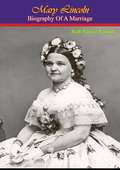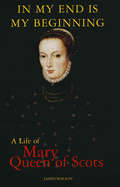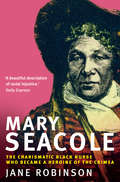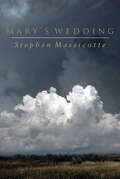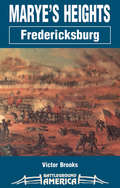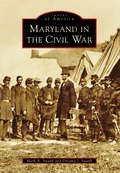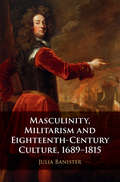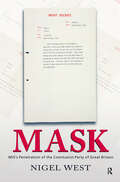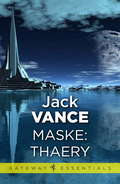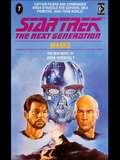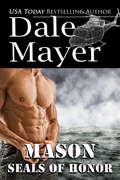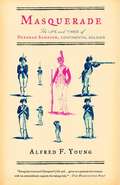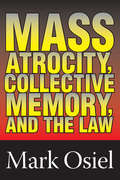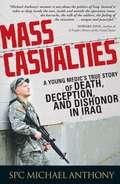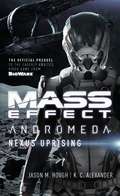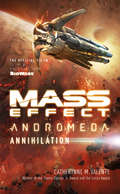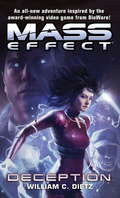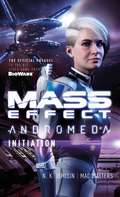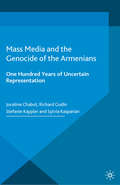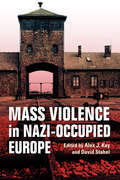- Table View
- List View
Mary Lincoln: Biography Of A Marriage
by Ruth Painter RandallMore fascinating than fiction, this is the moving story of the most misunderstood woman in American history...The truth about Mary Lincoln has for nearly a century been hidden under a mountain of myth.They said Lincoln really loved Ann Rutledge. That he had tried to avoid marriage to Mary Todd, that his wife hurt him politically though she drove him to the Presidency, that she embarrassed him financially as well as socially and inflicted on him the agony of adjustment to her psychopathic personality.Now for the first time, the true woman beneath the myth is presented. The veil of legend surrounding Mary Lincoln is torn aside and an entirely new picture of a woman and a marriage emerges.Here, through the eyes of the people who knew the Lincolns, through the long-lost telegrams and letters they sent each other, comes the story of their day-to-day life together. It begins in Springfield, and there, many years later, it ends. But the truth of those years gives evidence to restore Mary Todd Lincoln to her rightful place in history and in the affections of the American people.Acclaimed by the critics..."Never has such a story seemed better worth telling or better told."--SATURDAY REVIEW"This is an important and definitive volume."--AMERICAN HISTORY REVIEW"Out of the most searching scrutiny ever leveled on the Lincolns' family affairs comes the picture of a tempestuous yet essentially happy marriage."--NEW YORK HERALD TRIBUNE"This is a very moving book. It is also a nice example of what a first-rate historian can do with a difficult subject."--THE NEW YORKER"It is a book that can be recommended without reservation: A combination of profound research and fine prose style, it meets both the requirements of the Lincoln scholar and the casual reader who is looking for a truly fascinating story."--SAN FRANCISCO CHRONICLE
Mary Queen of Scots: In My End is My Beginning
by Dr James MackayIn My End Is My Beginning is the story of Mary Queen of Scots (1542–87), the tragic heroine par excellence. Queen of an unfamiliar and troubled nation when she was a week old, it was her misfortune to be a pawn in the game of international politics throughout her life. Even in the brief period from 1561 to 1567 when she was ruler of Scotland in fact as well as in name, she was beset with problems that would have defeated a much stronger, more experienced monarch. A talented poet and a charismatic leader, she contended with a treacherous, self-serving nobility, the religious ferment of the Reformation, and the political ambitions of larger and more powerful neighbours. With little real authority and few resources, Mary’s reign was successful, until her disastrous marriage to the dissolute Darnley set in motion the events that brought about her downfall. For the last 20 years of her life she was a prisoner in the hands of her cousin, Elizabeth I of England, and the subject of treacherous plots and conspiracies. A hostage to fortune, she represented a threat and a rallying-point for English Catholics. Her tragic end was inevitable. Yet her life, with all its adventurous, failures and disasters, produced the son – James – who ultimately brought about the union of Scotland and England.In the End Is My Beginning uncovers the true facts of Mary’s life in the context of Anglo-Scottish relations and shows why, after more than 400 years, she remains arguably the greatest character in popular Scottish history.
Mary Seacole: The Charismatic Black Nurse Who Became a Heroine of the Crimea
by Jane RobinsonThe 'Greatest Black Briton in History' triumphed over the Crimea and Victorian England. "The Times" called her a heroine, Florence Nightingale called her a brothel-keeping quack, and Queen Victoria's nephew called her, simply, 'Mammy' - Mary Seacole was one of the most eccentric and charismatic women of her era. Born at her mother's hotel in Jamaica in 1805, she became an independent 'doctress' combining the herbal remedies of her African ancestry with sound surgical techniques. On the outbreak of the Crimean War, she arrived in London desperate to join Florence Nightingale at the Front, but the authorities refused to see her. Being black, nearly 50, rather stout, and gloriously loud in every way, she was obviously unsuitable. Undaunted, Mary travelled to Balaklava under her own steam to build the 'British Hotel', just behind the lines. It was an outrageous venture, and a huge success - she became known and loved by everyone from the rank and file to the royal family. For more than a century after her death this remarkable woman was all but forgotten. This, the first full-length biography of a Victorian celebrity recently voted the greatest black Briton in history, brings Mary Seacole centre stage at last.
Mary Seacole: The Charismatic Black Nurse Who Became a Heroine of the Crimea
by Jane RobinsonThe 'Greatest Black Briton in History' triumphed over the Crimea and Victorian England. "The Times" called her a heroine, Florence Nightingale called her a brothel-keeping quack, and Queen Victoria's nephew called her, simply, 'Mammy' - Mary Seacole was one of the most eccentric and charismatic women of her era. Born at her mother's hotel in Jamaica in 1805, she became an independent 'doctress' combining the herbal remedies of her African ancestry with sound surgical techniques. On the outbreak of the Crimean War, she arrived in London desperate to join Florence Nightingale at the Front, but the authorities refused to see her. Being black, nearly 50, rather stout, and gloriously loud in every way, she was obviously unsuitable. Undaunted, Mary travelled to Balaklava under her own steam to build the 'British Hotel', just behind the lines. It was an outrageous venture, and a huge success - she became known and loved by everyone from the rank and file to the royal family. For more than a century after her death this remarkable woman was all but forgotten. This, the first full-length biography of a Victorian celebrity recently voted the greatest black Briton in history, brings Mary Seacole centre stage at last.
Mary's Wedding
by Stephen MassicotteOn the night before her wedding, Mary dreams of a thunderstorm, during which she unexpectedly meets Charlie sheltering in a barn beside his horse. With innocence and humour, the two discover a charming first love. But the year is 1914, and the world is collapsing into a brutal war. Together, they attempt to hide their love, galloping through the fields for a place and time where the tumultuous uncertainties of battle can’t find them. A play with a heart as big as the skies that serve as its stage, Mary’s Wedding is an epic, unforgettable story of love, hope, and survival.
Marye's Heights: Fredericksburg
by Victor BrooksFredericksburg was one of the most tragic battles of the Civil War. No sector was more hotly contested than the area held by Longstreet's troops and known as Marye's Heights. While the heights seemed impregnable to the charging Union troops, Longstreet's men took heavy casualties and many times felt they were on the point of being overrun. The latest Battleground America volume covers the actions, units and personalities of this key section of the Fredericksburg battlefield and describes in detail the area as it was in 1862 and the national park that occupies the site today.
Maryland in World War I (Images of America)
by William M. ArmstrongThe First World War was an unprecedented event, and some of its effects on the state of Maryland can be seen to this day. Maryland’s civilian contributions included agricultural and industrial production, providing goods ranging from canned oysters to light artillery pieces. Wartime industrial requirements led to the creation of entire communities, including Dundalk. Maryland hosted a variety of military facilities, many of which are still active. The largest was Camp Meade, a virtual city, one of 16 new National Army training cantonments that sprang up in a matter of weeks in the summer of 1917. Other major facilities included the US Naval Academy, Fort McHenry, Naval Proving Ground Indian Head, and the new Aberdeen Proving Ground. The state’s military contributions also included regional units of the National Guard and new National Army, which fought during the most deadly battle in American history, the Meuse-Argonne Offensive.
Maryland in the Civil War (Images of America)
by Mark A. Swank Dreama J. SwankAs a border state between the North and South during the Civil War, Maryland's loyalties were strong for both sides. The first casualties of the war occurred during the Baltimore Riot of April 19, 1861, when members of the 6th Massachusetts Regiment were attacked by Confederate supporters while traversing through the city on their way to protect Washington, DC, from attack. Ten days later, Maryland chose not to secede from the Union by a vote of 53-13. On September 17, 1862, near Sharpsburg, one of the largest and bloodiest battles of the Civil War took place at "Bloody Antietam." At the end of the day, nearly one in four men would be a casualty of the battle, making it the bloodiest day in American military history. There were over 75 skirmishes, raids, and major battles that took place in Maryland during the Civil War. Through vintage photographs, Maryland in the Civil War shares the state's rich military heritage.
Masculinity, Militarism and Eighteenth-Century Culture, 1689–1815
by Banister JuliaThis book investigates the figure of the military man in the long eighteenth century in order to explore how ideas about militarism served as vehicles for conceptualizations of masculinity. <P><P>Bringing together representations of military men and accounts of court martial proceedings, this book examines eighteenth-century arguments about masculinity and those that appealed to the 'naturally' sexed body and construed masculinity as social construction and performance. Julia Banister's discussion draws on a range of printed materials, including canonical literary and philosophical texts by David Hume, Adam Smith, Horace Walpole and Jane Austen, and texts relating to the naval trials of, amongst others, Admiral John Byng. <P>By mapping eighteenth-century ideas about militarism, including professionalism and heroism, alongside broader cultural concerns with politeness, sensibility, the Gothic past and celebrity, Julia Banister reveals how ideas about masculinity and militarism were shaped by and within eighteenth-century culture.<P> Provides a multifaceted discussion of the ideas surrounding the figure of the military man in the long eighteenth century.<P> Investigates ideas of masculinity through case studies of five court-martials of such men as Admiral John Byng.<P> Draws on the work of a range of writers from Hume to Austen as well as other less often studied printed sources.
Mask: MI5's Penetration of the Communist Party of Great Britain
by Nigel WestMI5’s dramatic interception of secret signals to Moscow from a hidden base in Wimbledon uncovered the true extent of Soviet espionage in Britain. Intelligence expert Nigel West reveals how MASK, the codename for one of the most secretive sources ever run by British intelligence, enabled Stanley Baldwin and his cabinet to monitor the activities of the Communist Party of Great Britain and track wireless traffic between the Soviet Union and its Comintern representatives abroad, in countries as far apart as the United States, China and Austria. The Government Code and Cipher School was one of the most secret branches of Whitehall, under the command of the Secret Intelligence Service, and used its covert intercept station in Denmark Hill, South London to make vital advances in the intelligence war. This gripping account exposes for the first time how the Communist Party of Great Britain was infiltrated and the actual contents of its communications with the Soviets.
Maske: Thaery (Gateway Essentials #198)
by Jack VanceThere is a Hole at the eastern fringe of the known universe. Deep within it hangs a lost star, Mora, with twin planets, Maske and Skay. On wild Maske there is a rocky peninsula inhabited by a clan of warlike dreamers, the Droads. The eldest son, Trewe, is by birthright Droad of Droad. The second son has no choice but to turn his face toward adventure. His name is Jubal Droad...
Masks (Star Trek: The Next Generation #7)
by John VornholtThe Enterprise journeys to Lorca, a beautiful world where the inhabitants wear masks to show their rank and station. There, Captain Picard and an away team begin a quest for the planet's ruler and the great Wisdom Mask that the leader traditionally wears. Their mission: establish diplomatic relations. But Picard and his party lose contact with the ship, and Commander Riker leads a search party down to the planet to find them. Both men are unaware that their searchs are part of a madman's plan. A madman who is setting a trap that will ensnare both landing parties, and leave him poised to seize control of the awesome Wisdom Mask... And the planet Lorca itself.
Mason (SEALs of Honor #1)
by Dale MayerKILL OR BE KILLED Part of an elite SEAL team, Mason takes on the dangerous jobs no one else wants to do – or can do. When he’s on a mission, he’s focused and dedicated. When he’s not, he plays as hard as he fights. Until he meets a woman he can’t have but can’t forget. Software developer, Tesla lost her brother in combat and has no intention of getting close to someone else in the military. Determined to save other US soldiers from a similar fate, she’s created a program that could save lives. But other countries know about the program, and they won’t stop until they get it – and get her. Time is running out... For her... For him... For them...
Masquerade: Amazing Deception and Camouflage Strategies of World War II
by Seymour ReitSeymour Reit's quiet wit and riveting style walks the reader through multiple types of deception and camouflage used by both Allied and Axis powers during World War II.
Masquerade: The Life and Times of Deborah Sampson, Continental Soldier
by Alfred F. YoungAlfred F. Young scrapes through layers of fiction and myth to uncover the story of Deborah Sampson, a Massachusetts woman who passed as a man and fought as a soldier for seventeen months toward the end of the American Revolution. Deborah Sampson was not the only woman to pose as a male and fight in the war, but she was certainly one of the most successful and celebrated. She managed to fight in combat and earn the respect of her officers and peers, and in later years she toured the country lecturing about her experiences and was partially successful in obtaining veterans' benefits. Her full story, however, was buried underneath exaggeration and myth (some of which she may have created herself), becoming another sort of masquerade. Young takes the reader with him through his painstaking efforts to reveal the real Deborah Sampson in a work of history that is as spellbinding as the best detective fiction.
Mass Atrocity, Collective Memory, and the Law
by Mark OsielTrials of those responsible for large-scale state brutality have captured public imagination in several countries. Prosecutors and judges in such cases, says Osiel, rightly aim to shape collective memory. They can do so hi ways successful as public spectacle and consistent with liberal legality. In defending this interpretation, he examines the Nuremburg and Tokyo trials, the Eicnmann prosecution, and more recent trials in Argentina and France. Such trials can never summon up a "collective conscience" of moral principles shared by all, he argues. But they can nonetheless contribute to a little-noticed kind of social solidarity.To this end, writes Osiel, we should pay closer attention to the way an experience of administrative massacre is framed within the conventions of competing theatrical genres. Defense counsel will tell the story as a tragedy, while prosecutors will present it as a morality play. The judicial task at such moments is to employ the law to recast the courtroom drama in terms of a "theater of ideas," which engages large questions of collective memory and even national identity. Osiel asserts that principles of liberal morality can be most effectively inculcated in a society traumatized by fratricide when proceedings are conducted in this fashion.The approach Osiel advocates requires courts to confront questions of historical interpretation and moral pedagogy generally regarded as beyond their professional competence. It also raises objections that defendants' rights will be sacrificed, historical understanding distorted, and that the law cannot willfully influence collective memory, at least not when lawyers acknowledge this aim. Osiel responds to all these objections, and others. Lawyers, judges, sociologists, historians, and political theorists will find this a compelling contribution to debates on the meaning and consequences of genocide.
Mass Casualites
by Spc Michael AnthonyA young medic's true story of death, deception, and dishonor in Iraq
Mass Casualties
by Michael AnthonyFrom the Introduction: "Look around," the drill sergeant said. "In a few years, or even a few months, several of you will be dead. Some of you will be severely wounded or so badly mutilated that your own mother can't stand the sight of you. And for the real unlucky ones, you will come home so emotionally disfigured that you wish you had died over there." It was Week 7 of Basic Training . . . 18 years old and I was preparing myself to die. They say the Army makes a man out of you - but for 18-year-old SPC Michael Anthony, that fabled rite of passage proved a very dark journey. After soliciting his parents' approval to enlist at only 17, Anthony began his journey with an unshakeable faith in the military born of his family's long tradition of service. But when thrust into a medical unit of misfits as lost as he was, SPC Anthony not only witnessed the unspeakable horror of war--but the undeniable misconduct of the military--firsthand. Everything he ever believed in dissolved, forcing Anthony to rethink his loyalties, and ultimately risk his career--and his freedom--to challenge the military he had so firmly believed in. This searing memoir chronicles the iconic experiences that changed one young soldier forever. A seasoned veteran before the age of twenty-one, he faced the truth about the war - and himself - in this shocking and unprecedented eyewitness account.
Mass Casualties: A Young Medic's True Story of Death, Deception, and Dishonor in Iraq
by Michael AnthonyFrom the Introduction:"Look around," the drill sergeant said. "In a few years, or even a few months, several of you will be dead. Some of you will be severely wounded or so badly mutilated that your own mother can't stand the sight of you. And for the real unlucky ones, you will come home so emotionally disfigured that you wish you had died over there." It was Week 7 of Basic Training . . . 18 years old and I was preparing myself to die. They say the Army makes a man out of you - but for 18-year-old SPC Michael Anthony, that fabled rite of passage proved a very dark journey. After soliciting his parents’ approval to enlist at only 17, Anthony began his journey with an unshakeable faith in the military born of his family's long tradition of service. But when thrust into a medical unit of misfits as lost as he was, SPC Anthony not only witnessed the unspeakable horror of war—but the undeniable misconduct of the military—firsthand. Everything he ever believed in dissolved, forcing Anthony to rethink his loyalties, and ultimately risk his career—and his freedom—to challenge the military he had so firmly believed in. This searing memoir chronicles the iconic experiences that changed one young soldier forever. A seasoned veteran before the age of twenty-one, he faced the truth about the war - and himself - in this shocking and unprecedented eyewitness account.
Mass Effect - Andromeda: Nexus Uprising
by Jason M. Hough K C Alexander<p>THE OFFICIAL TIE-IN TO THE LATEST INSTALLMENT OF ONE OF THE MOST POPULAR AND SUCCESSFUL GAME FRANCHISES EVER - MASS EFFECT <p>Titan Books will work closely with acclaimed video game developer BioWare to publish three brand new novels set in the universe of MASS EFFECT(TM): ANDROMEDA. The action will weave directly into the new game, chronicling storylines developed in close collaboration with the BioWare game team. <p>The action takes place concurrently with the adventure of the game itself, setting up the story and events of the game adding depth and detail to the canonical MASS EFFECT saga.
Mass Effect: Annihilation
by Catherynne M. ValenteAn official tie-in to the hit video game Mass Effect: Andromeda, written by award-winning and New York Times bestselling author Catherynne M. ValenteAn official tie-in to the hit video game Mass Effect: Andromeda by James Tiptree Jr. and Locus Award-winner Catherynne M. Valente.The Quarian ark Keelah Si'yah sails toward the Andromeda galaxy, carrying 20,000 colonists from sundry races including the drell, the elcor, and the batarians. Thirty years from their destination, a routine check reveals drell lying dead in their pods, and a deadly pathogen on board. Soon, the disease is jumping species, and it quickly becomes clear that this is no accident. It's murder, and the perpetrator is still on board.The ship's systems rapidly degrade, and panic spreads among the colonists, for the virus yields a terrible swelling of the brain that causes madness, hallucinations, and dreadful violence. If the ship's crew can't restore their technology and find a cure, the Keelah Si'yah will never make it to the Nexus. Copyright © 2017-2018 Electronic Arts Inc. EA, the EA logo, Mass Effect, Mass Effect: Andromeda, BioWare and the BioWare logo are trademarks of Electronic Arts Inc. All Rights Reserved.
Mass Effect: Deception
by William C. DietzThis novel continues the all-new, completely original story begun in the first three MASS EFFECT stories. The heroine, Gillian, was once the subject of horrifying scientific experiments, but now, after her rescue, she is beginning to master her amazing powers. But when she falls under the sway of a radical group who believes their powers make them superior to ordinary humans, she finds herself faced with a choice between her destiny . . . and her humanity.
Mass Effect: Initiation
by N. K. Jemisin Mac WaltersAn original novel written by Hugo Award-winning author N. K. Jemisin and Mass Effect creative director Mac WaltersLieutenant Cora Harper joined the Systems Alliance to develop and enhance her powerful biotic talents. She was assigned to the asari commando unit Talein’s Daughters, where she honed her abilities to become a skilled and deadly huntress.Returning to Earth, Cora finds herself a stranger among other humans, and joins the Andromeda Initiative as Alec Ryder’s second-in-command. The mission will send 100,000 colonists on a one-way, 600-year-long journey into the unknown. When essential—and dangerous—tech is stolen, Cora is assigned to recover it before it can be used against the Initiative, and end the mission before it can begin.
Mass Media and the Genocide of the Armenians: One Hundred Years of Uncertain Representation (Palgrave Studies in the History of Genocide)
by Stefanie Kappler Joceline Chabot Richard Godin Sylvia KasparianThe role of the mass media in genocide is multifaceted with respect to the disclosure and flow of information. This volume investigates questions of responsibility, denial, victimisation and marginalisation through an analysis of the media representations of the Armenian genocide in different national contexts.
Mass Violence in Nazi-Occupied Europe
by David Stahel Alex J. KayMass Violence in Nazi-Occupied Europe argues for a more comprehensive understanding of what constitutes Nazi violence and who was affected by this violence. The works gathered consider sexual violence, food depravation, and forced labor as aspects of Nazi aggression. Contributors focus in particular on the Holocaust, the persecution of the Sinti and Roma, the eradication of "useless eaters" (psychiatric patients and Soviet prisoners of war), and the crimes of the Wehrmacht. The collection concludes with a consideration of memorialization and a comparison of Soviet and Nazi mass crimes. While it has been over 70 years since the fall of the Nazi regime, the full extent of the ways violence was used against prisoners of war and civilians is only now coming to be fully understood. Mass Violence in Nazi-Occupied Europe provides new insight into the scale of the violence suffered and brings fresh urgency to the need for a deeper understanding of this horrific moment in history.
